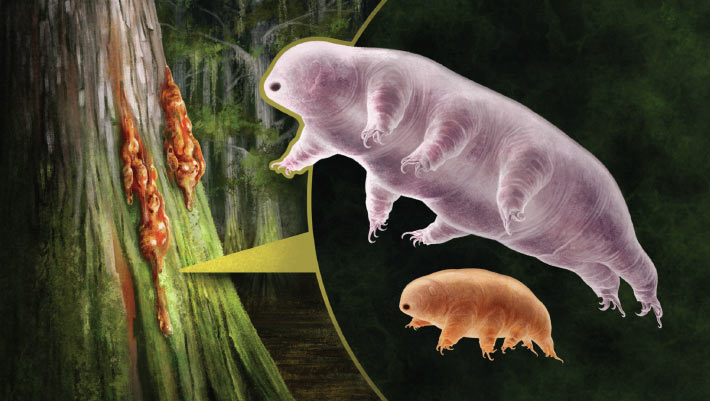Tardigrades are a diverse group of microscopic invertebrates widely known for their extreme survival capabilities. Molecular clocks suggest that tardigrades diverged from other panarthropods (arthropods, tardigrades, velvet worms and lobopodians) before the Cambrian period, but their fossil record is extremely sparse. Now, paleontologists have described a new species of tardigrade and redescribed a previously known species, Beorn leggi, both from Canadian Cretaceous-aged amber.
Artistic reconstruction of Beorn leggi (top) and Aerobius dactylus (bottom) in a hypothetical fossilization environment. Image credit: Franz Anthony.
First discovered in 1773, tardigrades are a diverse group of microscopic invertebrates that are best known for their ability to survive extreme conditions.
Also known as water bears or moss piglets, these creatures can live for up to 60 years, and grow to a maximum size of 0.5 mm, best seen under a microscope.
They are able to survive for up to 30 years without food or water, for a few minutes at temperatures as low as minus 272 degrees Celsius or as high as 150 degrees Celsius, and minus 20 degrees Celsius for decades.
Tardigrades withstand pressures from virtually 0 atm in space up to 1,200 atm at the bottom of the Marianas Trench, and are also resistant to radiation levels up to 5,000-6,200 Gy.
They survive by entering a state of suspended animation called biostasis, using proteins that form gels inside of cells and slow down life processes.
“Tardigrades are microscopic invertebrates characterized by a compact body plan with four pairs of typically claw-bearing lobopodous legs that are closely related to onychophorans and euarthropods as members of Panarthropoda,” said Harvard University Ph.D. candidate Marc Mapalo and colleagues.
“Tardigrades are popularly known for the cryptobiotic ability of some species that allow them to survive extreme conditions, such as space vacuum, ionizing radiation, and low subzero temperatures, as well as their worldwide distribution in marine, freshwater, and terrestrial habitats.”
“Despite their ubiquitous nature in the present-day biosphere, tardigrades have a notoriously scarce fossil record, which limits the study of their macroevolution including the origin of their body plan, and the timing of their terrestrialization and acquisition of cryptobiotic capabilities.”
“Currently, there are only four known crown-group tardigrade fossils, all of which are preserved as amber inclusions, but only two of them have well-established taxonomic positions relative to extant tardigrades.”
In their study, the authors looked at a piece of amber found in Canada in the 1960s that contains the known fossil tardigrade Beorn leggi and another presumed tardigrade that couldn’t be substantively described at the time.
Using confocal laser microscopy, a method usually employed for studying cell biology, they were able to examine the tiny structures of the fossil tardigrades in stunning detail.
The study provides not only a definitive classification of Beorn leggi in the tardigrade family tree, but the identification of a new species: Aerobius dactylus.
“Both of them are found in the same piece of amber that dates to the Cretaceous period, which means that these water bears lived alongside dinosaurs,” said Dr. Javier Ortega-Hernández, also from Harvard University.
“The images of Beorn leggi show seven well-preserved claws, with the claws that curve toward the body being smaller than those curving away from it, a pattern found in modern-day tardigrades.”
“The second, previously unidentified specimen, had claws of similar length on each of its first three pairs of legs, but longer outer claws on its fourth set of legs.”
Both species serve as critical calibration points for what’s called molecular clock analysis, which help scientists estimate the timing of key evolutionary events.
For example, the latest findings suggest that modern tardigrades likely diverged during the Cambrian period over 500 million years ago.
The study also sheds light on the origin of the remarkable ability of tardigrades to survive extreme conditions by entering a state of stasis.
“The study estimates that this survival mechanism likely evolved during the mid to Late Paleozoic, which may have played a crucial role in helping tardigrades endure the end-Permian mass extinction, one of the most severe extinction events in Earth’s history,” Dr. Ortega-Hernández said.
The results appear in the journal Communications Biology.
_____
M.A. Mapalo et al. 2024. Cretaceous amber inclusions illuminate the evolutionary origin of tardigrades. Commun Biol 7, 953; doi: 10.1038/s42003-024-06643-2

